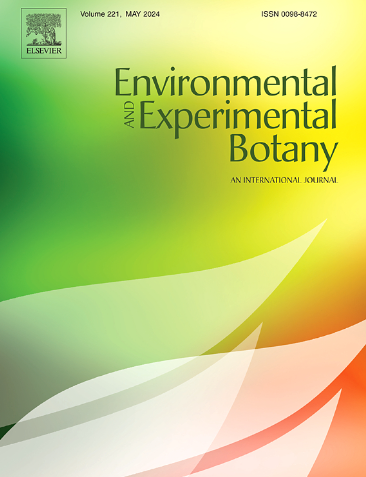Nitrogen allocation and trade-off among growth and defense strategies of ornamental herbaceous plants exposed to increasing ozone concentrations
IF 4.7
2区 生物学
Q2 ENVIRONMENTAL SCIENCES
引用次数: 0
Abstract
Nitrogen (N) allocation and trade-offs across primary and secondary metabolic pathways help to evaluate plant adaptive capacity to harsh environmental conditions. Tropospheric ozone (O3) is a major concern for ecosystem health, particularly in highly polluted cities like those of China. Here, Salvia splendens, Zinnia elegans and Helianthus annuus plants were exposed to ambient air (AA), moderate (AA+40 ppb, AA+40) and elevated (AA+80 ppb, AA+80) O3 concentrations to explore interspecific differences in N allocation and O3-response strategies. Photosynthetic rate (A) of S. splendens increased at 15 and 32 days from the beginning of the exposure (FBE; +24 % on average) under AA+ 40, whereas decreased in Z. elegans under both AA+ 40 and AA+ 80 (-24 %, on average, at 15 days FBE), and in H. annuus under AA+ 80 (-18 % at 32 days FBE). AA+ 80 reduced N based on leaf area (Narea) in all the three species. In addition, in S. splendens, AA+ 40 promoted N allocation to photosynthesis (Nphoto; +10 % at 32 days FBE) and decreased the N allocation to cell wall (NCW, -24 % throughout the entire exposure period), whereas in Z. elegans Nphoto was decreased at 15 and 48 days FBE (-38 %, on average) and no change was reported in NCW. Differently, both Nphoto and NCW decreased under AA+ 80 in all the three species. AA+40 maintained or improved the biomass production of S. splendens and Z. elegans, whereas H. annuus growth was inhibited. Overall, S. splendens and Z. elegans better adapted to AA+ 40 compared to H. annuus, which was attributed to increased contributions of Nphoto and N to chemical defense, highlighting species-specific strategies in adapting to O3-stress conditions.
臭氧浓度增加下观赏草本植物生长与防御策略的氮分配与权衡
氮(N)在初级和次级代谢途径中的分配和权衡有助于评估植物对恶劣环境条件的适应能力。对流层臭氧(O3)是生态系统健康的一个主要问题,特别是在像中国这样的高污染城市。以丹参(Salvia splendens)、百日草(Zinnia elegans)和向日葵(Helianthus annuus)为研究对象,分别暴露于环境空气(AA)、中等(AA+40 ppb、AA+40)和高浓度(AA+80 ppb、AA+80)的O3浓度环境下,探讨其氮素分配和O3响应策略的种间差异。黄芪的光合速率(A)在暴露后15天和32天有所增加(FBE);AA+ 40处理下,线虫的光合速率平均为+24 %),AA+ 40和AA+ 80处理下线虫的光合速率平均为-24 % (15 d), AA+ 80处理下线虫的光合速率平均为-18 % (32 d)。AA+ 80以叶面积(Narea)为基础降低了3种植物的氮素。此外,在S. splendens中,AA+ 40促进了氮分配到光合作用(Nphoto;在FBE 32天+10 %),并减少了细胞壁的N分配(NCW,整个暴露期间-24 %),而在线虫中,Nphoto在FBE 15和48天减少(平均-38 %),NCW没有变化。不同的是,在AA+ 80下,三种植物的Nphoto和NCW均有所下降。AA+40维持或提高了锦绣葡萄和秀丽隐杆线虫的生物量,而抑制了黄花葡萄的生长。总体而言,锦绣草和秀丽隐杆线虫对AA+ 40的适应能力优于黄花蒿,这主要归因于Nphoto和N对化学防御的贡献增加,凸显了物种适应臭氧胁迫条件的特异性策略。
本文章由计算机程序翻译,如有差异,请以英文原文为准。
求助全文
约1分钟内获得全文
求助全文
来源期刊

Environmental and Experimental Botany
环境科学-环境科学
CiteScore
9.30
自引率
5.30%
发文量
342
审稿时长
26 days
期刊介绍:
Environmental and Experimental Botany (EEB) publishes research papers on the physical, chemical, biological, molecular mechanisms and processes involved in the responses of plants to their environment.
In addition to research papers, the journal includes review articles. Submission is in agreement with the Editors-in-Chief.
The Journal also publishes special issues which are built by invited guest editors and are related to the main themes of EEB.
The areas covered by the Journal include:
(1) Responses of plants to heavy metals and pollutants
(2) Plant/water interactions (salinity, drought, flooding)
(3) Responses of plants to radiations ranging from UV-B to infrared
(4) Plant/atmosphere relations (ozone, CO2 , temperature)
(5) Global change impacts on plant ecophysiology
(6) Biotic interactions involving environmental factors.
 求助内容:
求助内容: 应助结果提醒方式:
应助结果提醒方式:


